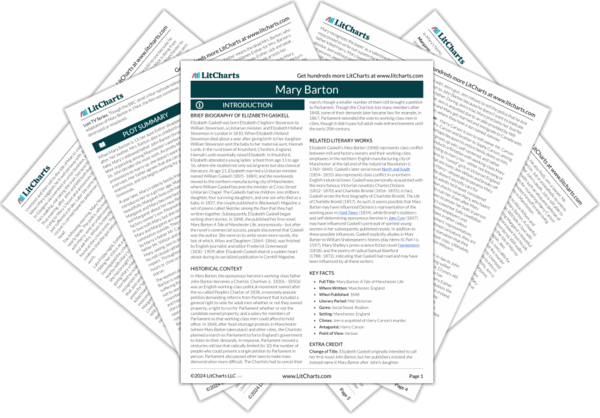In Mary Barton, the wadded shot used in the gun that kills Harry Carson symbolizes Mary Barton’s confused loyalties to Harry, her father John Barton, and her true love Jem Wilson. The paper that will eventually be repurposed as the wadded shot first appears when John Barton asks his daughter Mary to copy down a poem by the radical dialect poet Samuel Bamford (1788–1872). Mary has been flirting with mill owner’s son Harry Carson and ignoring working-class Jem Wilson, who loves her; as such, she uses the blank part of a valentine Jem sent her to copy down the poem and gives it to her father—showing her lack of interest in Jem’s romantic overtures and her current loyalty to Harry. By the time the paper makes its reappearance, Mary has realized she loves Jem, not Harry—yet unfortunately, Harry has been murdered and Jem arrested for the crime.
When Mary’s estranged aunt Esther finds the wadded shot near the crime scene, she brings it to Mary rather than the police because she sees Mary’s name and address on the paper and fears it will implicate her niece. Upon seeing the wadded shot, a horrified Mary realizes that Jem didn’t kill Harry—her father did, because he was the last one in possession of the valentine repurposed for the Bamford poem. Mary burns the wadded shot, even though she knows it could save the boy she loves, because it implicates her father in a hanging crime. When Mary burns the wadded shot, it shows her determination to remain loyal to her father and to absolve Jem in some other way, symbolizing how John’s violent radicalism forces Mary to divide her loyalties between her family and her romantic life.
Wadded Shot Quotes in Mary Barton
The corner of stiff, shining, thick, writing paper she recognised as a part of the sheet on which she had copied Samuel Bamford’s beautiful lines so many months ago—copied (as you perhaps remember) on the blank part of a valentine sent to her by Jem Wilson, in those days when she did not treasure and hoard up everything he had touched, as she would do now.










